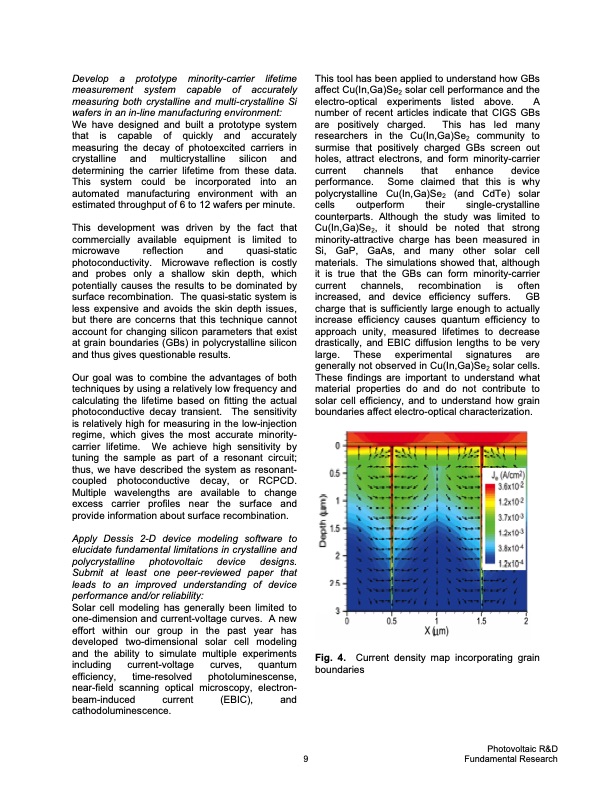
PDF Publication Title:
Text from PDF Page: 015
Develop a prototype minority-carrier lifetime measurement system capable of accurately measuring both crystalline and multi-crystalline Si wafers in an in-line manufacturing environment: We have designed and built a prototype system that is capable of quickly and accurately measuring the decay of photoexcited carriers in crystalline and multicrystalline silicon and determining the carrier lifetime from these data. This system could be incorporated into an automated manufacturing environment with an estimated throughput of 6 to 12 wafers per minute. This development was driven by the fact that commercially available equipment is limited to microwave reflection and quasi-static photoconductivity. Microwave reflection is costly and probes only a shallow skin depth, which potentially causes the results to be dominated by surface recombination. The quasi-static system is less expensive and avoids the skin depth issues, but there are concerns that this technique cannot account for changing silicon parameters that exist at grain boundaries (GBs) in polycrystalline silicon and thus gives questionable results. Our goal was to combine the advantages of both techniques by using a relatively low frequency and calculating the lifetime based on fitting the actual photoconductive decay transient. The sensitivity is relatively high for measuring in the low-injection regime, which gives the most accurate minority- carrier lifetime. We achieve high sensitivity by tuning the sample as part of a resonant circuit; thus, we have described the system as resonant- coupled photoconductive decay, or RCPCD. Multiple wavelengths are available to change excess carrier profiles near the surface and provide information about surface recombination. Apply Dessis 2-D device modeling software to elucidate fundamental limitations in crystalline and polycrystalline photovoltaic device designs. Submit at least one peer-reviewed paper that leads to an improved understanding of device performance and/or reliability: Solar cell modeling has generally been limited to one-dimension and current-voltage curves. A new effort within our group in the past year has developed two-dimensional solar cell modeling and the ability to simulate multiple experiments including current-voltage curves, quantum efficiency, time-resolved photoluminescense, near-field scanning optical microscopy, electron- beam-induced current (EBIC), and cathodoluminescence. This tool has been applied to understand how GBs affect Cu(In,Ga)Se2 solar cell performance and the electro-optical experiments listed above. A number of recent articles indicate that CIGS GBs are positively charged. This has led many researchers in the Cu(In,Ga)Se2 community to surmise that positively charged GBs screen out holes, attract electrons, and form minority-carrier current channels that enhance device performance. Some claimed that this is why polycrystalline Cu(In,Ga)Se2 (and CdTe) solar cells outperform their single-crystalline counterparts. Although the study was limited to Cu(In,Ga)Se2, it should be noted that strong minority-attractive charge has been measured in Si, GaP, GaAs, and many other solar cell materials. The simulations showed that, although it is true that the GBs can form minority-carrier current channels, recombination is often increased, and device efficiency suffers. GB charge that is sufficiently large enough to actually increase efficiency causes quantum efficiency to approach unity, measured lifetimes to decrease drastically, and EBIC diffusion lengths to be very large. These experimental signatures are generally not observed in Cu(In,Ga)Se2 solar cells. These findings are important to understand what material properties do and do not contribute to solar cell efficiency, and to understand how grain boundaries affect electro-optical characterization. Fig. 4. Current density map incorporating grain boundaries Photovoltaic R&D Fundamental Research 9PDF Image | DOE Solar Energy Technologies Program

PDF Search Title:
DOE Solar Energy Technologies ProgramOriginal File Name Searched:
38743.pdfDIY PDF Search: Google It | Yahoo | Bing
NFT (Non Fungible Token): Buy our tech, design, development or system NFT and become part of our tech NFT network... More Info
IT XR Project Redstone NFT Available for Sale: NFT for high tech turbine design with one part 3D printed counter-rotating energy turbine. Be part of the future with this NFT. Can be bought and sold but only one design NFT exists. Royalties go to the developer (Infinity) to keep enhancing design and applications... More Info
Infinity Turbine IT XR Project Redstone Design: NFT for sale... NFT for high tech turbine design with one part 3D printed counter-rotating energy turbine. Includes all rights to this turbine design, including license for Fluid Handling Block I and II for the turbine assembly and housing. The NFT includes the blueprints (cad/cam), revenue streams, and all future development of the IT XR Project Redstone... More Info
Infinity Turbine ROT Radial Outflow Turbine 24 Design and Worldwide Rights: NFT for sale... NFT for the ROT 24 energy turbine. Be part of the future with this NFT. This design can be bought and sold but only one design NFT exists. You may manufacture the unit, or get the revenues from its sale from Infinity Turbine. Royalties go to the developer (Infinity) to keep enhancing design and applications... More Info
Infinity Supercritical CO2 10 Liter Extractor Design and Worldwide Rights: The Infinity Supercritical 10L CO2 extractor is for botanical oil extraction, which is rich in terpenes and can produce shelf ready full spectrum oil. With over 5 years of development, this industry leader mature extractor machine has been sold since 2015 and is part of many profitable businesses. The process can also be used for electrowinning, e-waste recycling, and lithium battery recycling, gold mining electronic wastes, precious metals. CO2 can also be used in a reverse fuel cell with nafion to make a gas-to-liquids fuel, such as methanol, ethanol and butanol or ethylene. Supercritical CO2 has also been used for treating nafion to make it more effective catalyst. This NFT is for the purchase of worldwide rights which includes the design. More Info
NFT (Non Fungible Token): Buy our tech, design, development or system NFT and become part of our tech NFT network... More Info
Infinity Turbine Products: Special for this month, any plans are $10,000 for complete Cad/Cam blueprints. License is for one build. Try before you buy a production license. May pay by Bitcoin or other Crypto. Products Page... More Info
| CONTACT TEL: 608-238-6001 Email: greg@infinityturbine.com | RSS | AMP |